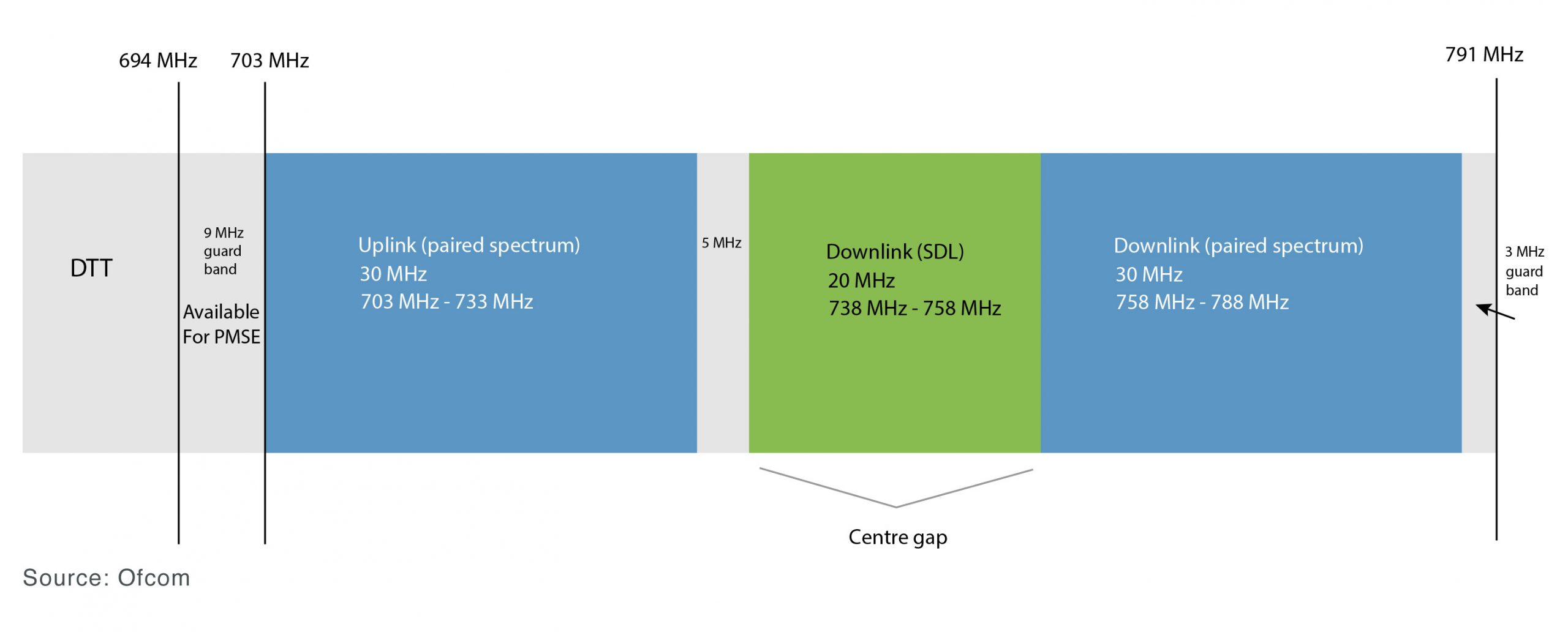Completion of Ofcom’s 5G 700 MHz and 3.6-3.8 GHz Spectrum Auction, and Observations
After delays due to legal challenges and Covid, Ofcom has in March and April finally held/completed its auction for the 700 MHz and 3.6-3.8 GHz spectrum (5G NR bands n28 and upper-n78 respectively). The results are announced at the following links: Principal Stage Results; Assignment Stage Results. The final (Assignment Stage) results were published on 27 April 2021.
The 700 MHz spectrum is vital for its ability to provide near-blanket coverage across the UK due to the better propagation at such frequencies. This will allow operators to transition their networks to 5G StandAlone (SA) operation, thereby phasing in a 5G (SA) core and being able to support the full functionality of 5G, and not requiring 4G coverage to be always present for control purposes (known as 5G Non-StandAlone—NSA). The 3.6-3.8 GHz spectrum is vital for the operators to be able to achieve at or close to the maximum performance possible in 5G NR Frequency Range 1 (FR1) with a single carrier, through use of the full (or near-full) 100 MHz 5G NR FR1 maximum carrier bandwidth. Such performance should potentially be 1 Gbps+, although depends on a multiple of other factors—such as the level of MIMO support deployed in base stations, level of MIMO support in the user’s mobile phone, the received signal strength, and concurrent usage by other users in the area among others.
There are several key observations that result from this auction:
- The paired 10 MHz of 700 MHz spectrum that EE, O2 and Three have each been awarded emphasizes the limitations at such frequencies.
a. Given the dense urban average spectral efficiency requirement for 5G of 7.8 b/s/Hz for example, this would achieve 78 Mbps on average.b. Perhaps more appropriately, given the rural average spectral efficiency requirement of 3.3 b/s/Hz, this would achieve 33 Mbps on average.c. This is clearly way short of the 100 Mbps “user experienced data rate” requirement for 5G, i.e., the user throughput that must be achieved in 95% of cases.d. EE might be able to achieve approximately 3x the performances indicated in (a) and (b) on the downlink, through the additional award of 20 MHz of supplementary downlink 700 MHz spectrum.e. One opportunity might be for operators to not only pool base stations via rural network sharing, but also a spectrum. Further investigation of this is necessary as a practical solution. If it were done, it would mean that full-bandwidth 20 MHz carriers at 700 MHz (5G NR n28) would be achievable, and devices would be able to more commonly achieve the 100 Mbps user experienced data rate requirement.f. High density base station deployments and near line-of-sight coverage will still be key to be able to achieve peak performances potentially of 1Gbps+ through providing coverage at 3.4-3.8 GHz (5G NR n78). This emphasizes the need for solutions such as Neutral Hosting and a further proliferation of rural network sharing—to the extent of deployment of new shared sites.g. It seems likely that Vodafone aims to achieve near-blanket coverage through the repurposing of their existing spectrum—notably the 5G NR n1 2.1 GHz (3G) spectrum, although perhaps also other bands.
- Only Three will have enough spectrum in a contiguous bandwidth in the 3.4-3.8 GHz range to achieve the theoretical upper limit of performance for 5G in FR1, through use of a full 100 MHz carrier. Further, Three could theoretically aggregate that with a further 40 MHz carrier, thereby achieving approximately 40% better performance still.
- The 3.6-3.8 GHz (n78) spectrum is still fragmented—even though the final “Assignment Stage” of the auction was meant to address fragmentation across the whole 3.4-3.8 GHz range. It seems likely—based on this—that EE, Vodafone, and O2 will encounter significant expense and technical challenges in widely achieving their full n78 bandwidths in coverage to users—as they will need to aggregate carriers. These full bandwidths are 90 MHz (50 MHz + 40 MHz) for Vodafone, and 80 MHz (40 MHz + 40 MHz) each for EE and O2.
Reference: ITU, “Minimum Requirements related to Technical Performance for IMT-2020 Radio Interface(s)”, November 2017, https://www.itu.int/dms_pub/itu-r/opb/rep/R-REP-M.2410-2017-PDF-E.pdf


